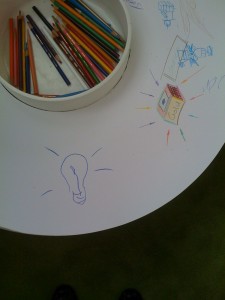DESIGN THINKING, IDEO, D-SCHOOL
/
The more I think about "All of Us as Accidental System Designers," the more I wonder about how to teach the skills. Yesterday I spent the afternoon on a field trip to IDEO with a group of visitors from Syngenta and Purdue University. My guess is that everyone at IDEO has the systems conductivity capabilities I've talked about. They are able to consider the broad range of both technical and behavioral options, and they have high intrinsic motivation for "having a positive impact" (be that more environmentally sustainable products, or impact on your firm's bottom line) in a way that thinks about meshing technology and practice together.
 I heard the phrase "design thinking" a lot during the presentations and tour. Tim Brown's (of IDEO) blog has an interesting discussion around the definition of design thinking. It opens with "Design thinking can be described as a discipline that uses the designer’s sensibility and methods to match people’s needs with what is technologically feasible and what a viable business strategy can convert into customer value and market opportunity."
IDEO has a strong connection to Stanford's "d-school," the Stanford Institute of Design. The d-school page has the following to say about "design thinking":
I heard the phrase "design thinking" a lot during the presentations and tour. Tim Brown's (of IDEO) blog has an interesting discussion around the definition of design thinking. It opens with "Design thinking can be described as a discipline that uses the designer’s sensibility and methods to match people’s needs with what is technologically feasible and what a viable business strategy can convert into customer value and market opportunity."
IDEO has a strong connection to Stanford's "d-school," the Stanford Institute of Design. The d-school page has the following to say about "design thinking":
 I heard the phrase "design thinking" a lot during the presentations and tour. Tim Brown's (of IDEO) blog has an interesting discussion around the definition of design thinking. It opens with "Design thinking can be described as a discipline that uses the designer’s sensibility and methods to match people’s needs with what is technologically feasible and what a viable business strategy can convert into customer value and market opportunity."
IDEO has a strong connection to Stanford's "d-school," the Stanford Institute of Design. The d-school page has the following to say about "design thinking":
I heard the phrase "design thinking" a lot during the presentations and tour. Tim Brown's (of IDEO) blog has an interesting discussion around the definition of design thinking. It opens with "Design thinking can be described as a discipline that uses the designer’s sensibility and methods to match people’s needs with what is technologically feasible and what a viable business strategy can convert into customer value and market opportunity."
IDEO has a strong connection to Stanford's "d-school," the Stanford Institute of Design. The d-school page has the following to say about "design thinking":
Having worked with hundreds of organizations to design products, services, and environments, we believe true innovation happens when strong multidisciplinary groups come together, build a collaborative culture, and explore the intersection of their different points of view. Many talk about multi-disciplinary collaboration, but few are actually successful at sustaining attempts to see what will happen. Even strong partners often lose interest because they cannot get along well enough or long enough to see the fruits of the collaboration. We believe having designers in the mix is key to success in multidisciplinary collaboration and critical to uncovering unexplored areas of innovation. Designers provide a methodology that all parties can embrace and a design environment conducive to innovation. In our experience, design thinking is the glue that holds these kinds of communities together and makes them successful.Their Tranformative Design Class looks wonderful: (Bill Moggridge of IDEO is one of the instructors)
Transformative Design examines the implications of design decisions: the ways in which your designs change the world, and also the ways in which the world changes your designs. In this project-based course you will learn how to employ interactive technologies to create designs to expressly encourage behavioral transformation. Class sessions will be structured around project work and interdisciplinary discussion of topics such as self-efficacy, social support, and mechanism of cultural change; accompanying lab sessions will familiarize students with basic hardware and software tools for interaction prototyping.I don't see a strong information technology focus at the d-school, beyond that mentioned in this course, but I may just be missing it. Modern information technologies often have an abstraction that makes their deep understanding -- a prelude to understanding how to include them in systems design -- more difficult than more concrete products. I've subscribed to the d-school blog and look forward to learning more about their programs.







